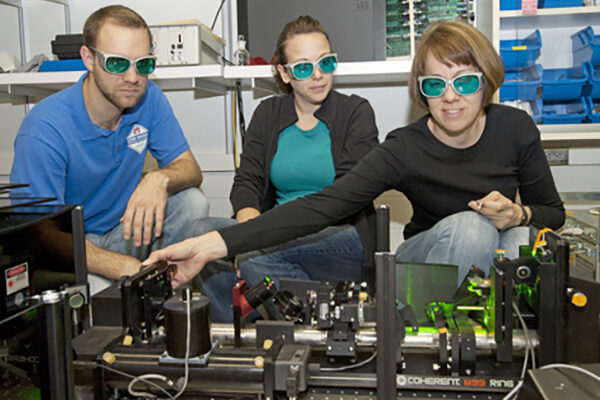Rhythmic firing of nerve cells involved in body’s movements
A new model for understanding how nerve cells in the
brain control movement may help unlock the secrets of the motor cortex, a
critical region that has long resisted
scientists’ efforts to understand it, researchers report June 3 in Nature.
Glides like balsa
Parkway South High School senior Will Mertz explains the design
of his team’s custom-built hand glider to Chris Kroeger, associate dean for students in
the School of Engineering & Applied Science, during the Boeing Engineering Challenge May 4 in the
Athletic Complex Field House. Mertz was among some 80 area high school students in 24
teams competing in the Boeing Challenge to determine which team’s glider had the
farthest flight, straightest path, longest hang time or
highest quality of flight.
The need for speed
WUSTL’s entry in Formula SAE, a student competition to
design and drive a Formula-style race car organized by the Society of
Automotive Engineers, was
unveiled May 7. The car did well in competition at the Michigan International Speedway — until the last event, where it lost its steering after the first lap of an endurance test.
Washington People: Sophia Hayes
Sophia Hayes, associate professor of chemistry in Arts & Sciences, was an undergraduate at the University of California, Berkeley, leaning toward an economics major when she stumbled into a quantum mechanics class and then a chemistry class with a collaborative research focus. Research projects were the hook, and “I crammed the chemistry major into my last two years,” Hayes says.
Arch Grants awards first $750,000 in grants
Eleven Washington University in St. Louis-affiliated entrepreneurs are among the winners of $750,000 in inaugural grants from Arch Grants, the global business plan competition providing $50,000 grants to startups and taking no equity in return. The 11 WUSTL-affiliated winners comprise five alumni, four faculty members and two students.
Lecture, symposium honors Sam Weissman’s 100th birthday
To recognize the 100th birthday of Sam Weissman, Manhattan Project scientist and beloved teacher who helped convert WUSTL’s Department of Chemistry in Arts & Sciences into a modern research department, the department is hosting a poster session, lecture and symposium Thursday and Friday, May 10 and 11.The festivities will include the second annual Weissman lecture, on the topic of the history of nuclear magnetic resonance, which will be delivered Thursday evening by Charles Slichter, PhD, emeritus professor of physics at the University of Illinois.
Math students score in Putnam, win and show in Missouri math competition
The Department of Mathematics has announced that a WUSTL team, consisting of senior Alex Anderson and juniors Tom Morrell and Ari Tenzer, placed 28th out of 460 teams in the demanding William Lowell Putnam Mathematics Competition. Two WUSTL teams also took first and third place in the 17th annual Missouri Collegiate Mathematics Competition. The winning team consisted of freshman Alan Talmage, and juniors Tom Moreel and Ari Tenzer.
Spector Prize goes to Fahey
The 2012 Spector Prize, which recognizes outstanding undergraduate acheivement in research, has been awarded to Paul Fahey, who graduated in December 2011 summa cum laude with a degree in biology. Fahey worked in the lab of Karen O’Malley, PhD, professor of neurobiology in the Department of Anatomy and Neurobiology at the School
of Medicine. His thesis focused on Fragile X syndrome, the most common
form of inherited mental retardation.
Prestigious national scholarships awarded to five WUSTL juniors
Five Arts & Sciences juniors have been awarded prestigious national scholarships. Winners of the Goldwater Scholarship are Rachel
Greenstein, a biology major, Jennifer Head, who is majoring in chemical
engineering, and Jenny Liu, who is majoring in electrical and biomedical
engineering. Madeleine Daepp, majoring in economics and mathematics, and Jeremy
Pivor, majoring in environmental biology with a minor in public health,
won the Udall Scholarship.
Engineers receive annual achievement awards
Seven distinguished alumni and a former dean of the School of Engineering &
Applied Science were honored at a dinner April 19 at the
Coronado Ballroom. Six received Alumni Achievement Awards, one a Young
Alumni Award, and the former dean received the Dean’s award. The honorees are: Larry Chiang, Richard Janis, Deepak Kantawala, Janice Karty, Milind Kulkarni, James McKelvey, Jr., Jennifer Dionne, and Sal Sutera.
Older Stories

